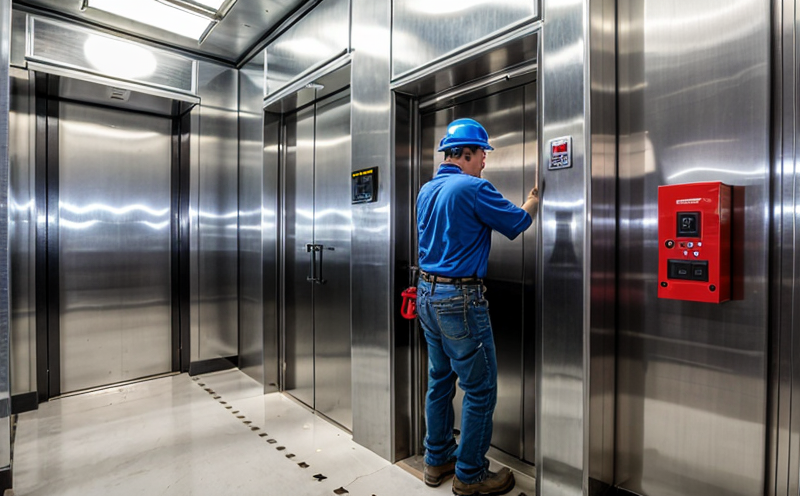Elevator brake system inspection
The elevator brake system is a critical component that ensures safe and reliable operation of elevators. The primary function of this system is to provide the necessary stopping force for the elevator car, ensuring it comes to a halt safely and securely at any floor level. Proper functioning of the brake is essential in preventing accidents such as free-fall or uncontrolled movement of the elevator.
The inspection process involves several key steps aimed at assessing the integrity, performance, and safety of the brake system. This includes visual inspections to identify any visible damage or wear, mechanical tests to evaluate the friction characteristics, and functional checks to simulate real-world operating conditions. Compliance with relevant standards such as ISO 18759 ensures that the inspection process adheres to globally recognized benchmarks for elevator safety.
The brake system is composed of various parts, including brake shoes or pads, a drum or disc, and an actuating mechanism. During the inspection, each component is scrutinized to ensure they meet specified tolerances and operational limits. For instance, brake lining thickness must not fall below certain thresholds as defined in ISO 20694. Additionally, hydraulic or pneumatic actuators are tested for pressure and flow rates to ensure consistent operation.
One of the most critical aspects of brake system inspection is the torque measurement. This involves applying a calibrated load to simulate the weight of an elevator car under full occupancy. The brake must lock effectively with minimal slippage, indicating proper engagement. Another crucial test is the emergency stop check, where the brake is actuated in various scenarios to confirm its reliability.
During the inspection process, it’s also important to consider environmental factors that can affect the performance of the brake system. Humidity and temperature variations may impact the friction properties of the materials used. Therefore, controlled testing environments are employed to ensure accurate results. The use of advanced diagnostic tools such as laser displacement sensors allows for precise measurement of displacements during braking.
- International Acceptance and Recognition: Elevator brake systems must meet strict standards recognized internationally to ensure their safety and reliability. Compliance with ISO 18759 ensures that the inspection process is consistent across different regions, enhancing trust in the quality of elevator services worldwide.
Quality and Reliability Assurance
The quality assurance (QA) process for elevator brake system inspections is designed to uphold high standards of safety and performance. This involves not only the inspection itself but also continuous monitoring and maintenance to ensure long-term reliability.
Data collected during inspections are meticulously documented, providing a comprehensive record that can be reviewed for trends or anomalies over time. This data-driven approach helps identify potential issues before they escalate into serious problems. Regular calibration of testing equipment ensures accuracy and consistency in measurements.
Training programs for inspectors play a vital role in maintaining the quality of inspections. These programs cover not only technical aspects but also best practices in communication and documentation, ensuring that all personnel involved in the inspection process are well-equipped to perform their duties effectively.
In addition to internal QA measures, independent third-party audits may be conducted periodically to validate compliance with established standards. Such audits provide an external perspective on quality control efforts, fostering confidence among stakeholders. The results of these audits can lead to improvements in existing processes and the introduction of new safety protocols if necessary.
Reliability assurance is achieved through rigorous testing procedures that simulate real-world conditions as closely as possible. This includes testing under varying loads, temperatures, and humidity levels to assess how well the brake system performs across different scenarios. By ensuring consistent performance in all tested conditions, reliability can be significantly enhanced, reducing the likelihood of unexpected failures.
International Acceptance and Recognition
- ISO 18759: Elevator and escalator safety—Safety requirements for elevator braking systems
- ASTM E3030-16: Standard Practice for Testing Braking Systems of Passenger Elevators
- EN 81-20: Safety regulations and rules for the construction, installation, operation and maintenance of passenger and freight lifts—Part 20: Lifts with power-operated doors
- IEC 63476-2: Elevator, escalator and moving walkway safety—Braking systems—Part 2: Testing methods
Environmental and Sustainability Contributions
The inspection of elevator brake systems contributes positively to environmental sustainability by ensuring that elevators operate efficiently. Efficient braking reduces energy consumption, which in turn lowers the carbon footprint associated with building operations. By maintaining optimal performance through regular inspections, unnecessary wear and tear on components can be minimized, extending their lifespan and reducing waste.
Moreover, compliance with international standards ensures that elevator systems are designed to meet current environmental regulations. This includes minimizing noise pollution during operation, which is particularly important in urban environments where quietness enhances the quality of life for residents. The use of eco-friendly materials in brake linings further supports sustainable practices by reducing the impact on natural resources.
Regular inspections also help identify potential inefficiencies early on, allowing for timely corrective actions that can improve overall system performance. This proactive approach not only promotes sustainability but also enhances safety and reliability, creating a positive feedback loop where each aspect of elevator maintenance contributes to the greater good.





